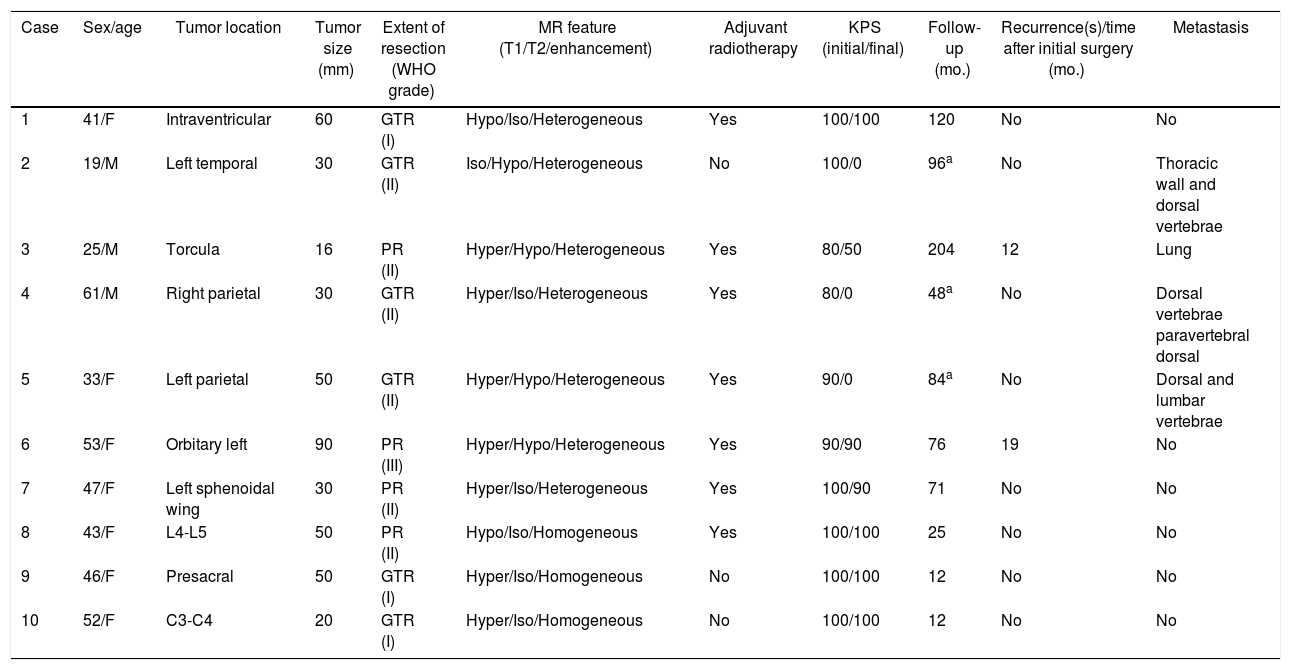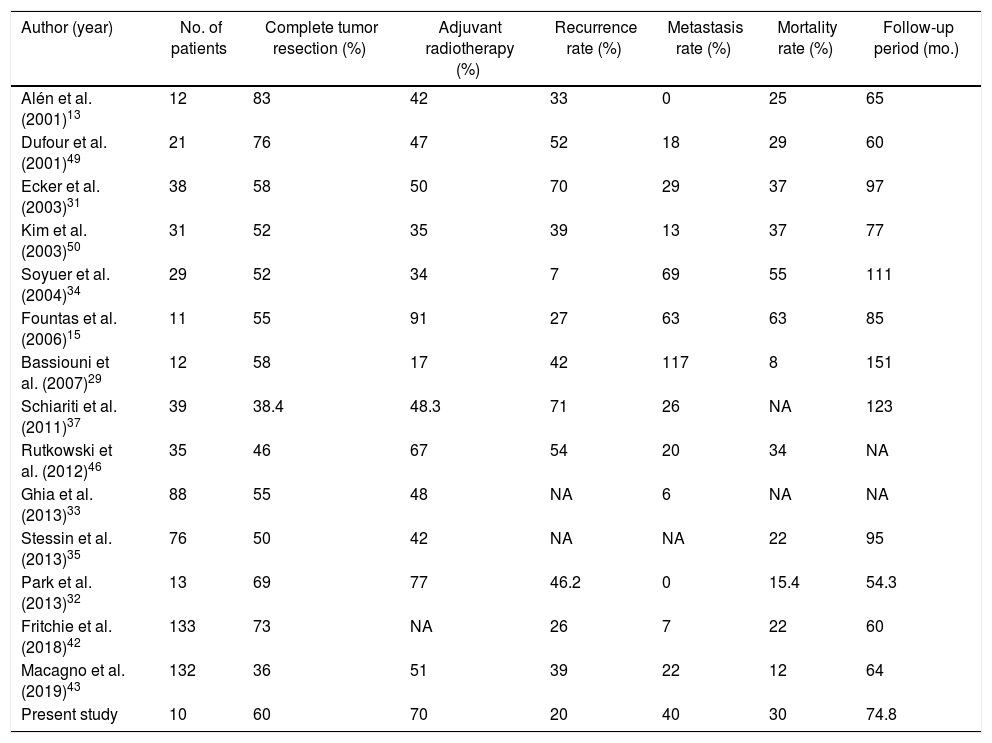Hemangiopericytoma and Solitary Fibrous Tumor are tumors with low incidence. They have a tendency to recur locally and to metastasize. The WHO integrated both tumors into a new entity but one of the pending issues is to demonstrate the effectiveness of surgery plus complementary radiotherapy (RT) and standardize the use of it. We reviewed the data from 10 years. We assessed pathologic and radiologic characteristics. The operation records were evaluated to determine the features and extent of tumor resection. We compared the outcomes in patients using or not RT. The mean follow-up was 74.8 months, with a range of 12 and 210 months. The population included 3 males (30%) and 7 females (70%). The most common location was brain convexity (30%), the remaining were cervical and lumbar spine, sacrum, intraventricular, torcular, sphenoid ridge and intraorbital. Postoperative external beam radiotherapy was delivered in 7 patients (70%), the criteria were a partial resection or WHO II and III histological grades. 2 patients developed local recurrences at 12 and 19 months after initial surgery. 1 patient underwent 2 surgeries, and the other, 4 surgeries. The mean recurrence free survival rate was 15.5 months. Distant metastases were found in 4 patients. 3 of the 10 patients died. Five-year overall survival rate was 66% and mean overall survival was 76 months. A safe and complete resection in the first surgery is the most important prognostic factor. Complementary RT can be helpful, even in cases of complete resection in WHO low-grade.
El hemangiopericitoma y el tumor fibroso solitario son enfermedades del sistema nervioso central (SNC) con una incidencia baja. Estos tumores también pueden tener algunas características como una tendencia a recurrir localmente y hacer metástasis. La OMS, en su última clasificación de tumores del SNC, integró ambos tumores en una nueva entidad: tumor fibroso solitario/hemangiopericitoma (SFT/HPC), pero uno de los problemas actuales pendientes es demostrar la efectividad de la cirugía y la radioterapia (RT) complementaria, y estandarizar el uso de la misma. Revisamos todos los datos clínicos de nuestro hospital en un período de 10 años, y encontramos 10 pacientes con SFT/HPC. Se evaluaron los tamaños de los tumores, las ubicaciones y las características radiológicas. Los registros quirúrgicos de cada paciente se evaluaron para determinar las características macroscópicas y el alcance de la resección del tumor (EOR). También comparamos los resultados en los pacientes que utilizan o no RT como tratamiento complementario. El seguimiento medio fue de 74,8 meses, con un rango de 12 y 210 meses. La población incluía 3 varones (30%) y 7 mujeres (70%). La localización más frecuente fue la convexidad cerebral (30%). Las distribuciones de las localizaciones restantes del tumor fueron columna cervical y lumbar, sacro, intraventricular, torcular, ala esfenoidal e intraorbitario. La radioterapia postoperatoria (EBRT) se administró en 7 pacientes (70%), los criterios para tratarlos fueron una resección parcial o un grado histológico de la OMS II y III. Dos pacientes desarrollaron recidivas locales a los 12 y 19 meses después de la cirugía inicial. Un paciente se sometió a 2 cirugías, y el otro a 4 cirugías. La tasa media de supervivencia libre de recidiva (RFS) fue de 15,5 meses. Se encontraron metástasis a distancia en 4 pacientes durante el período de seguimiento. Tres de los 10 pacientes fallecieron durante el período de seguimiento. La tasa de supervivencia general a 5 años fue del 66%, y la supervivencia media global fue de 76 meses. Una resección segura y completa en la primera cirugía es el factor pronóstico más importante. Consideramos que la RT complementaria puede ser útil, incluso en casos de resección completa en SFT/HPC de bajo grado. Sería interesante definir previamente la diferenciación entre el SFT/HPC y los meningiomas para las estrategias de tratamiento.
Article

If it is the first time you have accessed you can obtain your credentials by contacting Elsevier Spain in suscripciones@elsevier.com or by calling our Customer Service at902 88 87 40 if you are calling from Spain or at +34 932 418 800 (from 9 to 18h., GMT + 1) if you are calling outside of Spain.
If you already have your login data, please click here .
If you have forgotten your password you can you can recover it by clicking here and selecting the option ¿I have forgotten my password¿.
















